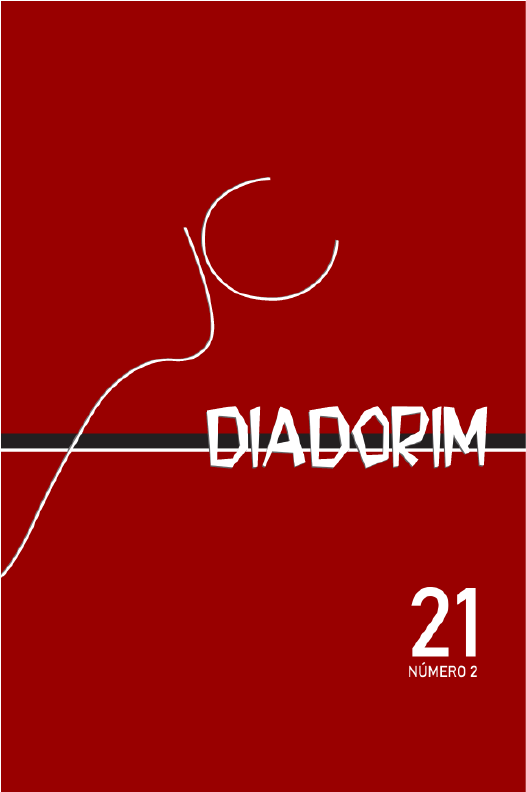STATIVE PREDICATES IN THE PROGRESSIVE IN BRAZILIAN PORTUGUESE
DOI:
https://doi.org/10.35520/diadorim.2019.v21n2a28398Keywords:
States, progressive, habitual predicates.Abstract
This paper aims to investigate in which contexts stative predicates are possible in the progressive in Brazilian Portuguese (BrP). In the literature, especially on English, this is unexpected, because progressive aspect is applied on events composed by stages (event predicates). States, however, are known as segmentally homogeneous, which means that: i) they have no stages and ii) they have the subinterval property of being true at minimal instants. In the present paper, we argue that the progressive aspect can be acceptable if a stage structure is grammatically licensed on the events denoted by the stative predicate. Moreover, we also found some similarities between the constraints on progressive statives in BrP and progressive habituals in English. Then we propose that the difference in the acceptability between stative predicates in the progressive in BrP (estar amando) and in English (is loving) comes from grammatical constraints on the composition of a stage structure between these languages, rather than semantic distinctions in the progressive.
References
BERTUCCI, R. Uma análise semântica para verbos aspectuais em português brasileiro [A semantic analysis on aspectual verbs in Brazilian Portuguese]. São Paulo: Universidade de São Paulo, 2011. Tese. (Doutorado em Semiótica e Linguística Geral). Programa de Pós-Graduação em Linguística. Departamento de Linguística, USP, 2011.
BERTUCCI, R.; LUNGUINHO, M. V.; PARAGUASSU, N. Bare plurals and achievements verbs: a case study of aspectual verbs. Journal of Portuguese Linguistics. v. 9, n. 1, p. 117-137, 2010.
DOWTY, D. Word Meaning and Montague Grammar. Dordrecht: Kluwer, 1979.
LANDMAN, F. The progressive. Natural Language Semantics n. 1, p. 1-32, 1992.
LANDMAN, F. 1066: differences between tense-perspective-aspect systems of English and Dutch’ In: ROTHSTEIN, S. (ed.). Theoretical and Crosslinguistic Approaches to the Semantics of Aspect. Amsterdam/Philadelphia: John Benjamins, 2008, p. 107-166.
LANDMAN, F.; ROTHSTEIN, S. Incremental homogeneity in the semantics of aspectual for-phrases. In: RAPPAPORT HOVAV, M; DORON, E.; SICHEL, I. (eds.), Syntax, Lexical Semantics and Event Structure. Amsterdam: Benjamins, 2010, p. 229-251.
LANDMAN, F.; ROTHSTEIN, S. The felicity of aspectual for-phrases – part 1: homogeneity. Language and Linguistics Compass n. 6, v. 2, p. 85-96, 2012a.
LANDMAN, F.; ROTHSTEIN, S. The felicity of aspectual for-phrases – part 2: incremental homogeneity. Language and Linguistics Compass n. 6, v. 2, p. 97-112, 2012b.
PARTEE, B. John is easy to please. In ZAMPOLLI, A. (ed.). Linguistic Structures Processing. Amsterdam: North-Holland, 1977, p. 281-312.
QUINE, W. V. O. Word and Object, The MIT Press, Cambridge, MA, 1960.
ROTHSTEIN, S. Fine-grained structure in the eventuality domain: the semantics of predicative adjective phrases and be. Natural Language Semantics, n. 7, p. 347-420, 1999.
ROTHSTEIN, S. Structuring events. Oxford: Blackwell, 2004.
SMITH, C. The Parameter of Aspect. Kluwer Academic Press, 1991.
SCHMITT, C. Semi-copulas – event and aspectual composition. In: KEMPCHINSKY, P.;
SLABAKOVA, R. (eds.). Aspectual Inquiries. Springer, 2005, p.121-145.
TAYLOR, B. Tense and Continuity. Linguistics and Philosophy, n. 1, v. 2, p. 199-200, 1977.
VENDLER, Z. Verbs and times. Philosophical Review, n. 56, p. 143-160, 1957.
VENDLER, Z. Linguistics in Philosophy. Ithaca: Cornell University Press, 1967.
ZAGONA, K. Ser and estar: phrase structure and aspect. In: NISHIDA, C.; RUSSI, C. (eds.), Selected Proceedings of Chronos 8. Cahiers Chronos, Amsterdam: Rodopi, p. 303-327, 2010.
ZUCCHI, S. Aspect shift. In: ROTHSTEIN, S. Events and Grammar. Dordrecht: Kluwer, 1998, p. 349-370.
Downloads
Published
Issue
Section
License
Copyright transfer -- Authorization to publication
If the submitted article is approved for publication, it is already agreed that the author authorizes UFRJ to reproduce it and publish it in Diadorim: revista de estudos linguísticos e literários, the terms "reproduction" and "publication" being understood as defined respectively by items VI and I of article 5 of Law 9610/98. The article can be accessed both by the World Wide Web (WWW) and by the printed version, with free consultation and reproduction of a copy of the article for the own use of those who consult. This authorization of publication is not limited in time, and UFRJ is responsible for maintaining the identification of the author of the article.

The journal Diadorim: revista de estudos linguísticos e literários is licensed under a Creative Commons Attribuition-NonCommercial 4.0 International (CC BY-NC 4.0).

